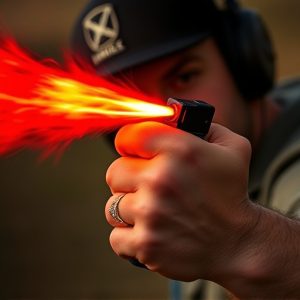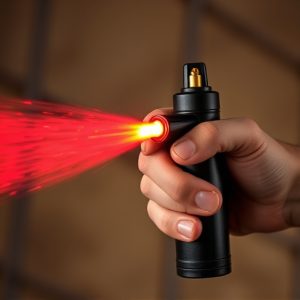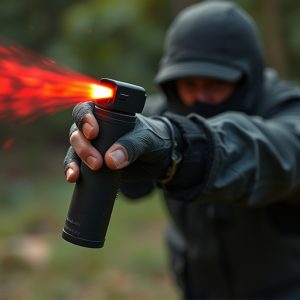Mastering Pepper Spray Safety: Eye Washing Procedure and Beyond
TL;DR:Pepper spray, a powerful self-defense tool using capsaicin, requires a specific eye washing pr…….
TL;DR:
Pepper spray, a powerful self-defense tool using capsaicin, requires a specific eye washing procedure after exposure. Immediately rinse eyes with clean, cold water for at least 15 minutes while keeping eyelids open to flush irritants and prevent damage. Don't rub eyes or wear contacts until rinsed thoroughly. Misconceptions about pepper spray's effects on vision are common; it causes temporary irritation, not permanent damage. Following this eye washing procedure significantly reduces discomfort and medical attention is recommended if symptoms persist. For enhanced safety, create an emergency plan, practice escape routes, and inform trusted individuals about your protocols.
Personal safety is paramount, especially in unpredictable situations. One effective tool for self-defense is inflammatory pepper spray, but understanding its mechanics and proper usage is crucial. This article delves into the science behind pepper spray, focusing on its composition and effects, while providing a comprehensive guide to the essential pepper spray eye washing procedure. We also debunk common misconceptions and offer additional precautions for long-term personal safety, ensuring you’re equipped with knowledge to protect yourself effectively.
- Understanding Pepper Spray: Its Composition and Effects
- The Importance of Proper Eye Washing After Exposure
- Step-by-Step Guide to Performing Eye Washing Procedure
- Common Misconceptions About Pepper Spray and Eye Safety
- Additional Precautions and Measures for Long-Term Personal Safety
Understanding Pepper Spray: Its Composition and Effects
Pepper spray, a powerful tool for personal safety, is a specialized type of chemical agent designed to incapacitate and deter potential threats. Its composition typically includes capsaicin, the active ingredient found in chili peppers, combined with various other chemicals to enhance its effectiveness and extend its reach. When deployed, pepper spray irritates the eyes, nose, throat, and skin, causing temporary yet intense discomfort, making it difficult for an attacker to continue their assault.
The eye washing procedure is a crucial step after exposure to pepper spray. It’s essential to rinse the eyes thoroughly with clean water for at least 15 minutes to dilute and flush out the irritants. This simple action can significantly alleviate pain and prevent potential long-term damage. Understanding how to properly use pepper spray and what to do afterward, like performing eye washing procedure, is an essential step in ensuring personal safety during encounters that involve this potent defense mechanism.
The Importance of Proper Eye Washing After Exposure
After exposure to pepper spray, proper eye washing procedure is of paramount importance for maintaining personal safety and minimizing discomfort. If your eyes are affected by pepper spray, do not rub them, as this can exacerbate the irritation. Instead, seek a safe, clean water source and thoroughly wash your eyes for at least 15 minutes. Hold your eyelids open and ensure that water flows over both the front and back of each eye.
The Pepper Spray Eye Washing Procedure should be carried out immediately after exposure to prevent long-term damage. It’s crucial to use a gentle, steady stream of clean, cold water, avoiding harsh scrubbing or contact lenses until the eyes have been thoroughly rinsed. If available, eye wash stations designed for chemical exposure can provide an even more effective and targeted flush.
Step-by-Step Guide to Performing Eye Washing Procedure
When dealing with pepper spray exposure, performing a quick and effective eye washing procedure is crucial for minimizing discomfort and potential damage. Here’s a step-by-step guide to ensure your safety:
1. Immediate Response: As soon as you come into contact with pepper spray, seek clean water immediately. Accessing water within 15 seconds can significantly reduce the impact of the irritants.
2. Rinse Thoroughly: Hold your eyes open and rinse them thoroughly under a steady stream of clean, running water for at least 15-20 minutes. Ensure that water flows into both eyes from the top, bottom, and sides to wash away all traces of pepper spray. If you have access to eye washing stations or containers with clean water, use those as they are designed specifically for this purpose.
3. Avoid Rubbing Eyes: It’s natural to want to rub your eyes but resist the urge. Rubbing can further irritate the eyes and potentially spread the irritants, causing more harm than good.
4. Seek Medical Attention if Necessary: After thorough rinsing, assess how you feel. If symptoms persist or worsen, seek medical attention immediately. Some individuals may experience more severe reactions requiring professional care.
Common Misconceptions About Pepper Spray and Eye Safety
Many people hold misconceptions about pepper spray and its effects on eye safety, often due to misinformation or a lack of understanding. One common misconception is that pepper spray will cause permanent damage to vision, but this is not true when used appropriately. In fact, it’s a temporary irritant designed to disable an attacker long enough for you to escape. The primary concern with pepper spray exposure to the eyes is discomfort and irritation, not lasting harm.
Another prevalent myth is that eye washing after pepper spray exposure is unnecessary. However, this couldn’t be further from the truth. If your eyes are exposed to pepper spray, it’s crucial to follow a specific eye washing procedure as soon as possible. Rinse both eyes thoroughly with clean water for at least 15 minutes to dilute and flush away the chemicals. This simple step can significantly reduce discomfort and irritation. Remember, seeking medical attention promptly is also recommended if symptoms persist or worsen.
Additional Precautions and Measures for Long-Term Personal Safety
In addition to carrying pepper spray, it’s crucial to familiarize yourself with proper safety precautions and first aid measures. If pepper spray comes into contact with your eyes, immediately perform the eye washing procedure: hold your affected eye open and gently pour clean water from a nearby source for at least 15 minutes, ensuring thorough irrigation. Seek medical attention if irritation persists or vision is compromised.
For long-term personal safety, consider creating an emergency plan and keeping pepper spray readily accessible. Regularly review and practice escape routes, and inform trusted individuals about your whereabouts and safety protocols. Staying informed about local laws and regulations regarding self-defense tools like pepper spray is also essential.
Understanding how to properly handle pepper spray exposure is crucial for personal safety. By knowing the composition and effects of this powerful irritant, along with the correct eye washing procedure, individuals can mitigate risks significantly. Remember, quick and thorough eye washing after exposure is key in reducing discomfort and potential long-term damage. Always be prepared, follow the step-by-step guide, and stay informed to ensure your safety and well-being.


